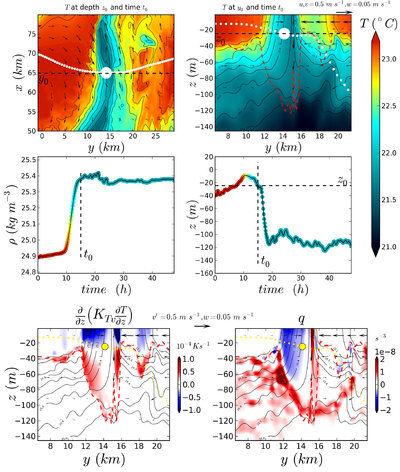Submesoscale Processes
Surface submesocale cold filaments
A set of realistic, very high resolution simulations is made for the Gulf Stream region using the oceanic model ROMS to study the life cycle of the intense submesoscale cold filaments that form on the subtropical gyre interior wall of the Gulf Stream.

Vertical section of along-front velocity (in colors), cross-front and vertical velocities (vectors) and temperature (black contours) for a submesoscale cold filament.
The surface buoyancy gradients and ageostrophic secondary circulations intensify in response to the mesoscale strain field as predicted by the theory of filamentogenesis. It can be understood in terms of a dual frontogenetic process, along the lines understood for a single front. There is, however, a stronger secondary circulation due to the amplification at the center of a cold filament.

Vertical sections of the different terms of the turbulent thermal wind balance for a cold filament in the cross-front direction.
Filament dynamics in the presence of a mixed layer is not adequately described by the classical thermal wind balance. The effect of vertical mixing of momentum due to turbulence in the surface layer is of the same order of magnitude as the pressure gradient and Coriolis force and contributes equally to a so-called turbulent thermal wind balance (TTW).

SST (in colors),surface relative vorticity (black contours), and surface velocity (vectors) for the evolution of a submesoscale cold filament.
Filamentogenesis is disrupted by vigorous submesoscale instabilities. The cause of the instability is the lateral shear as energy production by the horizontal Reynolds stress is the primary fluctuation source during the process; this contrasts with the usual baroclinic instability of submesoscale surface fronts.

Trajectory of a Lagrangian particle moving across the filament and downwelling in the center of the filament into the pycnocline.
The filaments are lines of strong oceanic surface convergence as illustrated by the release of Lagrangian parcels in the Gulf Stream. Diabatic mixing is strong as parcels move across the filaments and downwell into the pycnocline. The life cycle of a filament is typically a few days in duration, from intensification to quasi-stationarity to instability to dissipation.
Bibliography
| [1] | J. Gula, J. Molemaker and J.C. McWilliams (2014)
Submesoscale cold filaments in the Gulf Stream.
J. Phys. Oceanogr., 44, p2617-2643.
|

| [2] | J.C. McWilliams, J. Gula, J., M.J. Molemaker, L. Renault & A. Shchepetkin (2015)
Filament frontogenesis by boundary layer turbulence.
J. Phys. Oceanogr., In Press.
|
